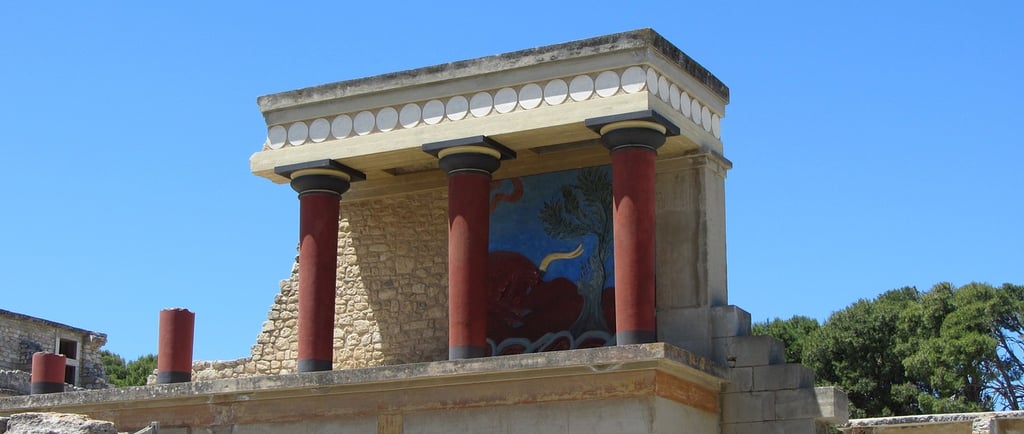🌴 The Minoans: Governance in Peaceful Palaces at the Island of Crete!
The Minoans were master sailors, skilled traders, and brilliant architects. But how did they govern their peaceful, prosperous society without kings or huge walls to protect their cities?
GEOGRAPHY STORIES
10/23/20243 min read


Let’s imagine for a moment that we’re standing on the edge of a sparkling blue sea 🌊, where the sun is shining bright ☀️, and the air smells like salt and flowers 🌸. As we look out over the water, we see beautiful ships with large sails, carrying treasures from distant lands—golden pottery, shiny jewelry, and the sweet smell of olive oil. Now imagine we are traveling back in time, over 3,000 years ago, to a place where people built huge palaces and created amazing artwork. This is the world of the Minoans, one of the most magical and powerful civilizations to ever exist on the island of Crete. 🏝️🏛️
Giant palaces with colorful paintings on the walls, courtyards where people are leaping over bulls 🐂, and grand ships sailing off to trade with faraway lands. This is the land ruled by the famous King Minos, whose palace was said to be so big and mysterious, it even had a maze called a labyrinth that hid a terrible creature, half-man and half-bull, called the Minotaur! 🐂👹
Let’s imagine being a Minoans and see how they lived, and governed themselves.🌍✨
Each city had a leader , who lived in large palaces, like the famous Palace of Knossos. These leaders helped make decisions for the people. They decided what should be built, organized festivals, and made sure that the laws were followed so everyone could live peacefully. 🏛️
To help keep the cities running smoothly, there were helpers who worked with the leaders. These helpers made sure people payed taxes, but not with money but by giving part of their harvest—like grain, olives, or animals—to the palaces. The palaces then stored the food and supplies for the people to use later. 🌾🏺
The Minoans were also very religious. They believed in many gods 🌟, and they thought that nature—like the sea, the mountains, and the animals—was special. The priests 🛕, who were also important leaders, made sure the people worshiped the gods correctly. They held religious ceremonies and made offerings to keep the gods happy and bring good luck to the island.
🚢. The Minoans were great sailors and traded with another civilizations living around Meditarenean Sea. They were trading things like wool, wine, and olive oil for precious metals like gold and beautiful stones like lapis lazuli.
One of the most interesting things about this civilization was that their cities didn’t have big walls or fortresses 🏰. This might seem strange because many ancient cities built walls to protect themselves from enemies. They lived in harmony with nature and were master sailors who explored the seas and brought wealth to their cities. But one day, something mysterious happened. One of the theory is that a huge volcano erupted on the nearby island of Thera (now known as Santorini) 🌋, causing earthquakes and tsunamis that damaged their cities. This weakened the Minoans, and soon after, they were taken over by the Mycenaeans, a group from mainland Greece. 🛡️
I wonderwhy the Minoans didn’t build big walls or focus on creating a large army? 🛡️🌾🏺
Questions to wonder aloud :
"How do you think the leaders of the Minoan palaces kept everything running smoothly in such big, busy places?" 🏛️👑
"What do you think it was like to live in a palace like Knossos, with its colorful art and large courtyards?"🎨🏰
"How do you think the Minoans managed to trade with faraway places without modern ships or navigation tools?" 🚢🧭
"What do you think the bull-leaping ceremony was like, and why was it so important to the Minoans?" 🐂🎉
"Why do you think priests played such important roles in Minoan society and religion?" 🧑🤝🧑🛕
"What kind of religious ceremonies do you think the Minoans performed to keep their gods happy?" 🌟🛕
By mentioning the invasion by the Mycenaeans, we open the door to exploring another ancient civilization. The Mycenaeans were a powerful group from mainland Greece who eventually took over the Minoans after their cities were weakened by natural disasters. This could lead children to wonder: who were the Mycenaeans, and how did they live? This also connects to the idea of migration—when groups of people move from one place to another. Just like the Mycenaeans took over Crete, people throughout history have moved for many reasons, whether because of war, natural disasters, or the search for better lands.
With Montessori joy,
Vanina 😊

